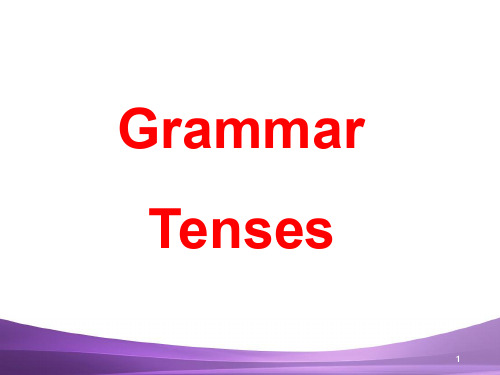中考英语 时态复习课件
合集下载
中考英语时态语态复习课件(共34张ppt)

时态语态专练
1.一般现在时:主语+(am, is, are ) 或 主语+do\does
2.一般过去时:主语+(was, were) 或 主语+did
3.一般将来时:主语+will+ do
4.现在进行时:主语+am\is \are +doing ;
5.过去进行时:主语+was/were+ doing
注:将来进行时、现在完成进行时、过去完成进行时通 常any a new
house ______(build) at present in
the disaster area. many a +n.(单数)+谓语
(单数),表“许许多多”
build---built--built
优秀ppt公开课ppt免费课件下载免费 课件20 20中 考英语 时态语 态复习 课件( 共34张 ppt)
5.表示动作发生在过去,强调动作的延续性, 常常与since\for\so far\up to now\ever since\in the past years\over the past days 等连用,
6.将来进行时: 主语+will + be +doing
7.过去将来时:
主语+would +do
8.现在完成时:
主语+have/has+ done
9.现在完成进行时: 主语+have/has been +doing
10.过去完成时: 主语+had +done
11.过去完成进行时: 主语+had +been +doing
1.一般现在时:主语+(am, is, are ) 或 主语+do\does
2.一般过去时:主语+(was, were) 或 主语+did
3.一般将来时:主语+will+ do
4.现在进行时:主语+am\is \are +doing ;
5.过去进行时:主语+was/were+ doing
注:将来进行时、现在完成进行时、过去完成进行时通 常any a new
house ______(build) at present in
the disaster area. many a +n.(单数)+谓语
(单数),表“许许多多”
build---built--built
优秀ppt公开课ppt免费课件下载免费 课件20 20中 考英语 时态语 态复习 课件( 共34张 ppt)
5.表示动作发生在过去,强调动作的延续性, 常常与since\for\so far\up to now\ever since\in the past years\over the past days 等连用,
6.将来进行时: 主语+will + be +doing
7.过去将来时:
主语+would +do
8.现在完成时:
主语+have/has+ done
9.现在完成进行时: 主语+have/has been +doing
10.过去完成时: 主语+had +done
11.过去完成进行时: 主语+had +been +doing
最新中考英语复习:初中六大时态复习课件

4 . 在时间、条件状语从句中,主句用一般将来时,从句用一 般现在时表将来。标志:if (如果) / as soon as (一……就) We will go swimming if it __d_o_e_sn_’_t_r_ai_n__ (rain) tomorrow.
20
Book P4
1. Our science teacher said that light _____much faster than sound.
A.make B. will make C.am making D.making
2. Look! Some visitors ______for the bus over there.
A. are waiting B.is waiting C.waiting
D.wait
3.--- What is your mother doing, Linda?
用法:
1. 表示过去某一时刻或过去某个阶段正在进行的事或发生的 动作。
He fell asleep when he __wa_s__r_e_a_d_i_n_g___(read). We _w_er_e__w_a_t_c_h_i_ng___(watch) TV from seven to nine last night. He was cleaning his car while I __wa_s__c_o_o_k_i_n_g____(cook).
It was a clear day and warm now in the sun . The fog cleared from her eyes .
Keep silent.
Break the silence.
The electricity is off.
20
Book P4
1. Our science teacher said that light _____much faster than sound.
A.make B. will make C.am making D.making
2. Look! Some visitors ______for the bus over there.
A. are waiting B.is waiting C.waiting
D.wait
3.--- What is your mother doing, Linda?
用法:
1. 表示过去某一时刻或过去某个阶段正在进行的事或发生的 动作。
He fell asleep when he __wa_s__r_e_a_d_i_n_g___(read). We _w_er_e__w_a_t_c_h_i_ng___(watch) TV from seven to nine last night. He was cleaning his car while I __wa_s__c_o_o_k_i_n_g____(cook).
It was a clear day and warm now in the sun . The fog cleared from her eyes .
Keep silent.
Break the silence.
The electricity is off.
中考英语语法复习时态课件

buy ------------- have Tom has had this book since a week ago.
borrow ------------- keep How long have you kept this book?
die ------------- be dead leave ------------- be away close ------------- be closed
5. He fell asleep while he ____w_a_s__re_a_d_i_n_g__(read) a book.
6. I ___h_a_v_e_____ never _h_e_a_r_d_______ (hear) of that man before.
7. My brother often ____w__e_n_t_______ (go) for walks last summer.
结构: will do、 shall do、 be (is、am、are) going to do
时间状语:tomorrow、in +时间、
next…
Lily
Lucy
现在进行时
概念: 表示现在正在发生的动作 或一直反复进行的动作
结构: be (is, am, are) + doing
时间状语:Look! 、 Listen! 、 now、at the moment、these days
Mike is outgoing and he___h_a_s_____ (have) many friends. His favorite subject is Chinese. He ___h_a_s__le_a_r_n_e_d___ (learn) it for three years. Mike says when he __g_r_o_w_s____ (grow) up, he __w_i_ll_b_e_c_o_m__e_ (become) a professional basketball player or a doctor. He thinks __b_e_i_n_g___ (be) a doctor can ___h_e_lp____ (help) more people.
borrow ------------- keep How long have you kept this book?
die ------------- be dead leave ------------- be away close ------------- be closed
5. He fell asleep while he ____w_a_s__re_a_d_i_n_g__(read) a book.
6. I ___h_a_v_e_____ never _h_e_a_r_d_______ (hear) of that man before.
7. My brother often ____w__e_n_t_______ (go) for walks last summer.
结构: will do、 shall do、 be (is、am、are) going to do
时间状语:tomorrow、in +时间、
next…
Lily
Lucy
现在进行时
概念: 表示现在正在发生的动作 或一直反复进行的动作
结构: be (is, am, are) + doing
时间状语:Look! 、 Listen! 、 now、at the moment、these days
Mike is outgoing and he___h_a_s_____ (have) many friends. His favorite subject is Chinese. He ___h_a_s__le_a_r_n_e_d___ (learn) it for three years. Mike says when he __g_r_o_w_s____ (grow) up, he __w_i_ll_b_e_c_o_m__e_ (become) a professional basketball player or a doctor. He thinks __b_e_i_n_g___ (be) a doctor can ___h_e_lp____ (help) more people.
中考英语 时态复习课件

(4)表示意向的动词,如hope, wish, expect, think, intend, mean, suppose等,用过去完成时表示"原本…, 未能…“ We had hoped that you would come, but you didn't.
返2回8
一般过去时与现在完成时之比较
14
现在进行时
1. 表此时此刻正在进行的动作。 通常由表示“此刻”的时间状语(now, at this moment), 或通过Look/Listen!这两个提示语来表明此时此刻动作正在进行。
Listen, she is singing a song.
2.现阶段正在进行的动作或存在的状态。 They are studying hard this term.
5
4)在某些以here,there开头的句子中用一般现在时表正在发生的动作。 There goes the bell.
6
(5) 与一般现在时连用的时间状语 1) 表频度的副词,always, often, usually, sometimes 等。 2) On Sundays, on Monday afternoon , every day, every morning,
Grammar Tenses
1
时态
现在
过去
将来
过去将来
一般
一般现在
一般过去
一般将来
一般过去将 来
进行
现在进行
过去进行
将来进行
过去将来进 行
完成
现在完成行
现在完成进 过去完成进 将来完成进 过去将来完
行
行
行
成进行时
2
一般现在时
初中英语中考复习时态讲解课件(共79张ppt)

一般现在时
1. 表示经常性或习惯性的动作
She does excersice everyday.
真题链接
—What do you often do at weekends?
—I often ____ my grandparents.
A. visit
B. visited
C. have visited D. will visit
Just a moment, I am washing dishes.
when
习题
Just a minute! My brother________ his car in the garden. A. washes B. is washing C. washed D. will wash
习题
---Hey, Tom. Let’s go swimming.
动词过去分词 不规则变化
speak hear see give build swim buy teach
spoken heard seen given built swum bought taught
现在完成时
already yet
1.过去发生或已完成的某一动作对现在的影响。
I have already watched this film. I haven't watched this film yet. I have already visited America. I haven't visited America yet.
A. prepares
B. is preparing
C. has prepared D. prepared
真题链接
--Mum, it's late. Why are you still here? --Dad hasn't come back yet. I ____ for him. A. am waitingB. was waiting C. waited D. had waited
2023年中考英语复习动词时态、语态 课件

He has been a League member for three years. (是团员的状态可持续)
He joined the League three years ago. ( 三年前入团,joined为短暂行为。)
I have finished my homework now. ---Will somebody go and get Dr. White? ---He's already been sent for.
I'd rather you came tomorrow.
4) wish, wonder, think, hope 等用过去时,作试探性 的询问、请求、建议等。如:
I thought you might have some. 我以为你想要一些。
比较:
一般过去时表示的动作或状态都已成为过去,现已 不复存在。
He is used to a vegetarian diet. Scarf is used to taking a walk.(现在习惯于散步)
典型例题
---- Your phone number again? I _A__ quite catch it. ---- It's 69568442. A. didn't B. couldn't C. don't D. can't
3) be +不定式表将来,按计划或正式安排将发 生的事。如:
We are to discuss the report next Saturday. 4) be about to +不定式,意为马上做某事。如:
He is about to leave for Beijing. 注意:be about to 不能与tomorrow, next week 等表示明确将来时的时间状语连用。
He joined the League three years ago. ( 三年前入团,joined为短暂行为。)
I have finished my homework now. ---Will somebody go and get Dr. White? ---He's already been sent for.
I'd rather you came tomorrow.
4) wish, wonder, think, hope 等用过去时,作试探性 的询问、请求、建议等。如:
I thought you might have some. 我以为你想要一些。
比较:
一般过去时表示的动作或状态都已成为过去,现已 不复存在。
He is used to a vegetarian diet. Scarf is used to taking a walk.(现在习惯于散步)
典型例题
---- Your phone number again? I _A__ quite catch it. ---- It's 69568442. A. didn't B. couldn't C. don't D. can't
3) be +不定式表将来,按计划或正式安排将发 生的事。如:
We are to discuss the report next Saturday. 4) be about to +不定式,意为马上做某事。如:
He is about to leave for Beijing. 注意:be about to 不能与tomorrow, next week 等表示明确将来时的时间状语连用。
2024年中考英语复习第十章:动词的时态和语态课件

在看电视。 2. 过去进行时常与always等表示频率的副词连用,表示过去频繁发生的习惯性动作。此 时的过去进行时有一点的感情色彩。 • Alice was always changing her mind. 爱丽丝总是改变主意。 时间状语:this morning, the whole morning, all day ,yesterday, from nine to ten
5. 对现在进行时的特殊疑问句的回答,它不可以用Yes或No直接作答,要根据实际
情况回答。
• -Yes,he is.是的。
-No,he isn't.不是。
现在进行时
现在分词的变化 1. 动词的后面直接加-ing。 • work-working,study-studying, play-playing 2. 以不发音的字母e结尾的动词,先去掉字母e,再加-ing。 • live-living 3. 以重读闭音节结尾并且只有一个辅音字母的动词,先双写这个辅音字母,再加- ing。 • stop-stopping,swim-swimming,run-running, get-getting
现在进行时
现在进行时的句式变化:
1. 肯定句式:主语+be( am, is, are)+现在分词+其它.
• Li Hua is cleaning the classroom.李华在打扫教室
2. 否定句式:主语+be(am, is, are) +not +现在分词+其它.
• Li Hua isn't cleaning the classroom.李华不是在打扫教室,
04
过去进行时
过去进行时
用法
5. 对现在进行时的特殊疑问句的回答,它不可以用Yes或No直接作答,要根据实际
情况回答。
• -Yes,he is.是的。
-No,he isn't.不是。
现在进行时
现在分词的变化 1. 动词的后面直接加-ing。 • work-working,study-studying, play-playing 2. 以不发音的字母e结尾的动词,先去掉字母e,再加-ing。 • live-living 3. 以重读闭音节结尾并且只有一个辅音字母的动词,先双写这个辅音字母,再加- ing。 • stop-stopping,swim-swimming,run-running, get-getting
现在进行时
现在进行时的句式变化:
1. 肯定句式:主语+be( am, is, are)+现在分词+其它.
• Li Hua is cleaning the classroom.李华在打扫教室
2. 否定句式:主语+be(am, is, are) +not +现在分词+其它.
• Li Hua isn't cleaning the classroom.李华不是在打扫教室,
04
过去进行时
过去进行时
用法
2023年中考英语专题精品课件--动词的时态课件

A. discuss
B. discussed
C. will discuss
12. Volunteers __C___ books and toys to some village schools next Monday.
A. send
B. sent
C. will send
13. —Bob, have you finished reading the book? 时态看问句
一般现在时表示将来 表示按规定或时间表预计将发生的动作 主将从现,用在以if、as soon as、until、when oon; next week/month...(next系列); in a week、in 2024、in+一段时间; one day、in the (near) future等
一般过去时与过去进行时
过去进行时--构成 主语+was/were +动词现在分词+其他 过去进行时--用法 表示过去某一时刻正在进行或发生的动作 表示过去某一时间段内正在进行或发生的动作 在含有时间状语从句的复合句中,延续时间较长的动作用过去进行时, 另一个短暂性动作用一般过去时 表示两个延续性动作在过去某一时刻同时进行时,不考虑动作的先后顺 序,主句和从句的谓语动词都用过去进行时,连词常用while
A. am talking
B. was talking
C. were talking
4. —Is this your camera?
—Yes, I ___C_____ it for two weeks. 现在完成时
A. bought
B. had
C. have had
5. As soon as she ___A__ in Nanning, she will call you.
初中英语中考时态复习课件

初中英语语法
动词的时态
一般现在时: Present Simple
概念: 表示习惯、经常性的动作
结构: do does is 动词+s/es
标志语:usually、often、never、
sometimes、once a week、 twice a month、every year
一般现在时--句型变化
1.The twins ___w__a_s_h____(wash) the
clothes every day.
2.Sometimes he __p_l_a_y__s_ (play)
basketball over there.
3.How often d_o__e_s Sally _s_i_n_g__(sing)?
• Is Danny a good student? 一般疑问句
• 其时间状语为often(经常)、 usually(通常)、
always(总是)、 sometimes(有时)等频率副词, on Saturdays(在星期六)、 in the morning(afternoon evening)(在早上(下午 晚 上)) 、every day(每天) 等。
• 一般疑问句的句式变化可分为两种情况: • 1) 一般人称作主语的 • 变否定句须在动词前加助动词don’t; • 变一般疑问句须在句首加助动词do。 • 例如:They have lunch at 12:00. 陈述句
•
They don’t have lunch at 12:00. 否定句
•
•
Do they have lunch at 12:00? 一般疑问句
现在完成时: Present Perfect
动词的时态
一般现在时: Present Simple
概念: 表示习惯、经常性的动作
结构: do does is 动词+s/es
标志语:usually、often、never、
sometimes、once a week、 twice a month、every year
一般现在时--句型变化
1.The twins ___w__a_s_h____(wash) the
clothes every day.
2.Sometimes he __p_l_a_y__s_ (play)
basketball over there.
3.How often d_o__e_s Sally _s_i_n_g__(sing)?
• Is Danny a good student? 一般疑问句
• 其时间状语为often(经常)、 usually(通常)、
always(总是)、 sometimes(有时)等频率副词, on Saturdays(在星期六)、 in the morning(afternoon evening)(在早上(下午 晚 上)) 、every day(每天) 等。
• 一般疑问句的句式变化可分为两种情况: • 1) 一般人称作主语的 • 变否定句须在动词前加助动词don’t; • 变一般疑问句须在句首加助动词do。 • 例如:They have lunch at 12:00. 陈述句
•
They don’t have lunch at 12:00. 否定句
•
•
Do they have lunch at 12:00? 一般疑问句
现在完成时: Present Perfect
中考英语八种时态复习课件

4)表示客观真理,客观存在,自然现象。
例如:The earth moves around the sun.
地球绕太阳转动。
5)表示按计划或安排好的将要发生的动作,可用 一般现在时表将来。但只限于 start,begin,leave,go,come,arrive,return等。
例如:The train leaves at six tomorrow morning.
2. 一般现在时的用法 :
1) 表示经常性的或习惯性的动作,常与表示频 率的副词连用。常用的频率副词有: always、 often、 usually、seldom、never。频率副词在句 中通常位于行为动词之前,系动词、助动词之 后。
例如: He often goes swimming in summer.
他夏天经常游泳。
I usually leave home for school at 7 every morning.每天早上我七点离开家去学校。
2)表示现在的状态。 例如: The boy is twelve. 这男孩十二岁。 3)表示主语具备的性格、特征和能力等。 例如: My sister is always ready to help others . 我妹妹总是乐于助人。 Ann writes good English but does not speak well. 安英语写得不错,讲的可不行。
1.改为一般疑问句并回答。 Did you do your homework yesterday? Yes, I did./No, I didn't. 2.改为否定句。
火车明天上午六点开。
6)在复合句中,当主句是一般将来时,时间状语 从句或条件状语从句的谓语动词只能用一般现在 时来表示将来。
- 1、下载文档前请自行甄别文档内容的完整性,平台不提供额外的编辑、内容补充、找答案等附加服务。
- 2、"仅部分预览"的文档,不可在线预览部分如存在完整性等问题,可反馈申请退款(可完整预览的文档不适用该条件!)。
- 3、如文档侵犯您的权益,请联系客服反馈,我们会尽快为您处理(人工客服工作时间:9:00-18:30)。
3. _D_i_d__ Sally _s_i_n_g___(sing) just now?
句型 结构:
主语+ was\were +其他. 主语+动词过去式+其他.
概念:
过去某个时间里发生的动作或状态; 过去习惯性、经常性的动作、行为
结构:(1) 主语+ was\were +其他.
(2) 主语+动词过去式+其他.
3. At that time, Danny w__a__s__lo_o__k_i_n_g_(look) out of the window .
主语+be (was,were) + doing+时间.
表示过去某段时间或某一时刻正在
概念: 发生或进行的动作及行为
结构: 主语+be (was,were) + doing+时间.
1.Sometimes he _p_la__y_s___ (play) basketball over there.
2.The teacher told us that the earth _g_o_e_s_(go) around the sun.
3. I think it ___is___ (be) a good idea!
动词第三人称单数
主语 I we you they 主语 he she it
肯定 I often go to school He often goes to
句 by bike.
主语+动词原形
school by bike .
主语+动词+ s\es( 三单)
否定 I don’t often go to 句 school by bike.
句型 结构
主语+be (is, am, are) + doing sth.
概念: 表示现在正在发生的动作 结构: 主语+be (is, am, are) + doing sth.
现在分词
标志词:Look! 、 Listen! 、now、
right now , at this time, at the moment, It’s +时间….
1. Look! She _i_s_l_y_i_n_g_ (lie) on the bed. 2. Listen! __I_s__ she t_a_l_k_i_n__g (talk) in the
classroom?
3. Jim _i_s__s_tu__d_y__in__g_(study) English right now.
时间状语:
at 9:30 yesterdht, at this time yesterday, at that time, when, while, as 引导的时间状语从句…
No. 3 一般现在时: Simple Present Tense
lying dying
No. 2 过去进行时: Past Continuous Tense
1.What _w__a__s he d__o_i_n_g_ (do) at seven o’clock yesterday morning?
2.We __W__a_s_n_’_t ___r_e_a_d__in__g____ (not read) books when the bell rang.
概念:
经常、反复发生的动作或行为及现在的某 种状况 ;客观真理
结构: (1) 主语+be(am, is, are)+其他
(2) 主语+动词原型\ 动词3单+其他.
时间状语:
always, usually, often, sometimes, seldom, never, once a week, twice a month, every day/night/week/year …
a time and tense axis
past
present
future
had done
did
was\were doing
do/does am/is/are doing
have/has done would/should do
will/shall do
No. 1 现在进行时: Present Progressive
Does +主语+动词原形?
一般情况动词后+s 以“辅音字母+y”结尾 的动词,变y为i,+es
以s, x, sh, ch, 和o 结尾的动词后面+es
不规则变化
run ask study fly
guess fix finish catch go
have
runs asks studies flies
guesses fixes finishes catches goes
has
No. 4 一般过去时: Simple Past Tense
1. I __w_a_s__ (be) very short when I was in primary school.
2. We _d__id_n_’_t__li_v_e_d__ (not live) in a small house two years ago.
主语+don’t +动词原形
一般 Do you often go to 疑问 school by bike ? 句 Do +主语+动词原形 ?
He does’t often go to school by bike .
主语+doesn’t +动词原形
Does he often go to school by bike ?
时间状语:
构成规则
yesterday, the day before yesterday,
just now, in 1992,
two days ago , a moment ago ,
last night \ week / month…
一般在动词后加-ed
一般在动词原形后 +ing 一般在动词原形后 +ing
重读闭音节以一个辅 音字母结尾的,双写
这一字母+ing
以ie结尾的重读开音 节,改ie为y+ing
go ask write take
get run swim
lie die
going asking writing taking
getting running swimming
句型 结构:
主语+ was\were +其他. 主语+动词过去式+其他.
概念:
过去某个时间里发生的动作或状态; 过去习惯性、经常性的动作、行为
结构:(1) 主语+ was\were +其他.
(2) 主语+动词过去式+其他.
3. At that time, Danny w__a__s__lo_o__k_i_n_g_(look) out of the window .
主语+be (was,were) + doing+时间.
表示过去某段时间或某一时刻正在
概念: 发生或进行的动作及行为
结构: 主语+be (was,were) + doing+时间.
1.Sometimes he _p_la__y_s___ (play) basketball over there.
2.The teacher told us that the earth _g_o_e_s_(go) around the sun.
3. I think it ___is___ (be) a good idea!
动词第三人称单数
主语 I we you they 主语 he she it
肯定 I often go to school He often goes to
句 by bike.
主语+动词原形
school by bike .
主语+动词+ s\es( 三单)
否定 I don’t often go to 句 school by bike.
句型 结构
主语+be (is, am, are) + doing sth.
概念: 表示现在正在发生的动作 结构: 主语+be (is, am, are) + doing sth.
现在分词
标志词:Look! 、 Listen! 、now、
right now , at this time, at the moment, It’s +时间….
1. Look! She _i_s_l_y_i_n_g_ (lie) on the bed. 2. Listen! __I_s__ she t_a_l_k_i_n__g (talk) in the
classroom?
3. Jim _i_s__s_tu__d_y__in__g_(study) English right now.
时间状语:
at 9:30 yesterdht, at this time yesterday, at that time, when, while, as 引导的时间状语从句…
No. 3 一般现在时: Simple Present Tense
lying dying
No. 2 过去进行时: Past Continuous Tense
1.What _w__a__s he d__o_i_n_g_ (do) at seven o’clock yesterday morning?
2.We __W__a_s_n_’_t ___r_e_a_d__in__g____ (not read) books when the bell rang.
概念:
经常、反复发生的动作或行为及现在的某 种状况 ;客观真理
结构: (1) 主语+be(am, is, are)+其他
(2) 主语+动词原型\ 动词3单+其他.
时间状语:
always, usually, often, sometimes, seldom, never, once a week, twice a month, every day/night/week/year …
a time and tense axis
past
present
future
had done
did
was\were doing
do/does am/is/are doing
have/has done would/should do
will/shall do
No. 1 现在进行时: Present Progressive
Does +主语+动词原形?
一般情况动词后+s 以“辅音字母+y”结尾 的动词,变y为i,+es
以s, x, sh, ch, 和o 结尾的动词后面+es
不规则变化
run ask study fly
guess fix finish catch go
have
runs asks studies flies
guesses fixes finishes catches goes
has
No. 4 一般过去时: Simple Past Tense
1. I __w_a_s__ (be) very short when I was in primary school.
2. We _d__id_n_’_t__li_v_e_d__ (not live) in a small house two years ago.
主语+don’t +动词原形
一般 Do you often go to 疑问 school by bike ? 句 Do +主语+动词原形 ?
He does’t often go to school by bike .
主语+doesn’t +动词原形
Does he often go to school by bike ?
时间状语:
构成规则
yesterday, the day before yesterday,
just now, in 1992,
two days ago , a moment ago ,
last night \ week / month…
一般在动词后加-ed
一般在动词原形后 +ing 一般在动词原形后 +ing
重读闭音节以一个辅 音字母结尾的,双写
这一字母+ing
以ie结尾的重读开音 节,改ie为y+ing
go ask write take
get run swim
lie die
going asking writing taking
getting running swimming
